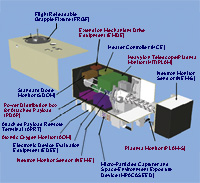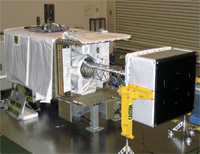This is an archive of information released in the past.
Disclaimer: It may contain broken links or outdated information. Some parts may not function in current web browsers.
*Visit https://humans-in-space.jaxa.jp/en/ for the latest information.

Experiment
- News
- Kibo Utilization Strategy
- Kibo Utilization Plan
- List of JAXA's Utilization Themes
- Experiment Facilities
- Space Environment Utilization
- Archive
News
- SEDA-AP Began Nominal Operations (September 19, 2009)
- Initial function checkouts of MAXI and SEDA-AP began (August 5, 2009)
Background
At the altitude of about 400km, where the International Space Station (ISS) is orbiting, there exists a harsh environment not only with microgravity, but also in a ultra high vacuum with more kinds of radiation (space radiation) than on the Earth (Figure 1). Especially when a huge explosion occurs on the surface of the Sun, a large amount of radiation comes to the Earth, which may trigger geomagnetic storms as well as disrupt power transmission networks and radio wave transmitting/receiving systems. The Space Environment Data Acquisition Equipment - Attached Payload (SEDA-AP) was designed to observe and predict the space weather outside the Earth’s atmosphere by measuring such space radiation and accumulating the data.
The SEDA-AP will also conduct experiments to expose an off-the-shelf solid lubricant and electronic devices to the space environment for a long period, to study the decay resistance of materials, for space use of such commercial products.
In addition, the Attached Payload BUS for Kibo Exposed Facility Payload (APBUS) was developed to provide an accessible environment for experiment operators. This APBUS will be used for the SEDA-AP to conduct technical demonstration of the SEDA-AP's instruments on orbit.
What is Space Environment Data ?
The SEDA-AP, equipped with many sensors and measurement instruments, will conduct quantitative measurements of the space environment (neutrons, heavy-ions, plasmas, high-energy light particles, atomic oxygen, and dust), material exposure experiments, and electronic device evaluation experiments, in order to study the effects of the space environment on the materials (Figure 2 and Figure 3). Space environment data obtained on orbit will be used as fundamental data for designing space-related equipment, as well as for related science experiments, operation of the ISS, and space weather forecasting (prediction of the solar activities).
Neutron Monitor (NEM)
Neutron radiation is very harmful to humans because it is electrically neutral due to its high penetrating nature. The Neutron Monitor (NEM) will measure the neutron radiation in real-time.
Heavy Ion Telescope (HIT)
The Heavy Ion Telescope (HIT) will measure the energy distributions of each heavy ions (from Li to Fe), which could be one of the reasons for malfunction and damage to electronic devices.
Plasma Monitor (PLAM)
The Plasma Monitor (PLAM) will measure the density and electron temperature of space plasma, which could cause spacecraft electric charging and discharging.
Standard Dose Monitor (SDOM)
The Standard Dose Monitor (SDOM) will measure the energy distributions of each high-energy light particle (electron, proton, alpha ray, etc), which could cause degradation of material for devices and malfunction of electronic devices.
Atomic Oxygen Monitor (AOM)
Atomic oxygen causes degradation on thermal control and coating materials, which could negatively affect thermal control of the ISS. The Atomic Oxygen Monitor (AOM) will measure the amount of atomic oxygen on the ISS's orbit.
Electronic Device Evaluation Equipment (EDEE)
The Electronic Device Evaluation Equipment (EDEE) will evaluate space radiation-induced single event phenomena and degradation of electronic devices used onboard Kibo. In a single event phenomenon, a space radiation particle impinging upon the device could give rise to temporal malfunction and permanent damage to circuits of the electronic devices.
Micro-Particles Capturer (MPAC)
The Micro-Particles Capturer (MPAC) will capture small particles existing on the ISS’s orbit. After being returned to the ground, the size, composition, and impact energy of captured particles will be evaluated.
Space-Environment Exposure Device (SEED)
In the Space-Environment Exposure Device (SEED) experiment, material for space use (thermal control material, solid lubricant, etc) will be directly exposed to the space environment. After being returned to the ground, degradation of the space material by the space environment, including space radiation and atomic oxygen, will be evaluated.
Observation Plan
The SEDA-AP will be launched aboard NASA’s Space Shuttle, and installed on Kibo’s Exposed Facility (EF). It will start observations with sensors and measurement instruments after deploying the extensible mast more than 1m. At the end of the extended mast, a box containing the Neutron Monitor-Sensor (NEM-S) and the Plasma Monitor-Sensor (PLAM-S) is mounted. Experiments (observation and data acquisition) will be conducted continuously and simultaneously over three years.
Experiment specimens of the Micro-Particles Capturer and Space-Environment Exposure Device (MPAC&SEED) installed on the outer surface of the SEDA-AP will be retrieved after experiments conducted by astronauts during the Extravehicular Activity (EVA) and returned to the ground.
Organization
 |
Principal Investigator (PI)
Tateo GOKA Leader of Space Environment Group, Aerospace Research and Development Directorate, JAXA |
| Copyright 2007 Japan Aerospace Exploration Agency | Site Policy |

